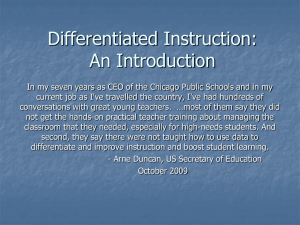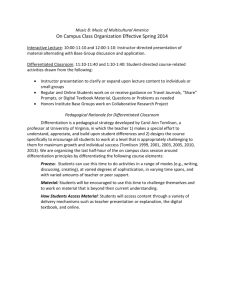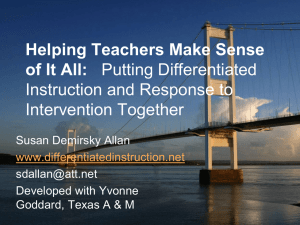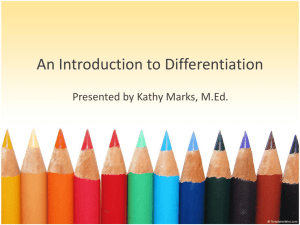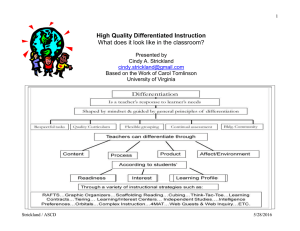NERDS XII Differentiating Instruction
advertisement
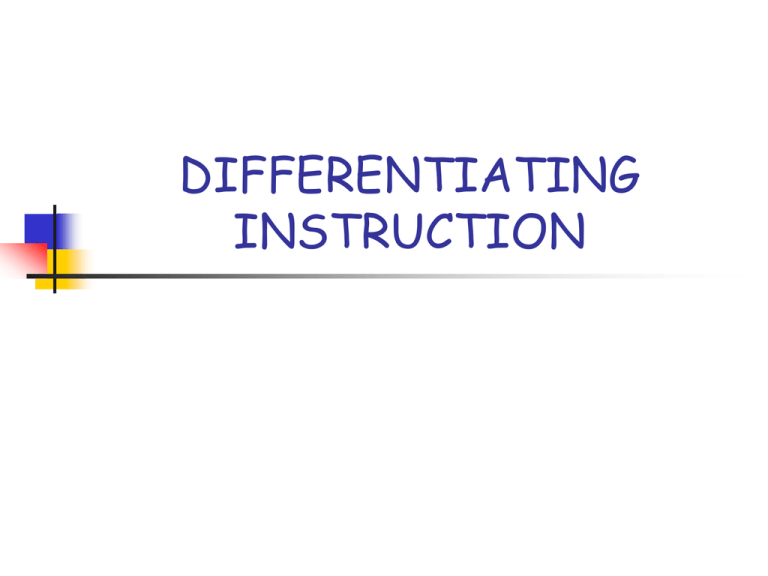
DIFFERENTIATING INSTRUCTION Differentiation: A Way of Thinking About the Classroom Differentiation is not a recipe for teaching. It is not an instructional strategy. It is not what a teacher does when she or he has time. It is a way of thinking about teaching and learning. It is a philosophy. Differentiation is based on a set of beliefs: Students who are the same age differ in their readiness to learn, their interests, their styles of learning, their experiences, and their life circumstances. Differentiation is based on a set of beliefs: The differences in students are significant enough to make a major impact on what students need to learn, the pace at which they need to learn it, and the support they need from teachers and others to learn it well. Differentiation is based on a set of beliefs: Students will learn best when supportive adults push them slightly beyond where they can work without assistance. Students will learn best when they can make a connection between the curriculum and their interests and life experiences. Differentiation is based on a set of beliefs: Students learn best when learning experiences are natural. Students are more effective learners when classrooms and school create a sense of community in which students feel significant and respected. The central job of school is to maximize the capacity of each student. In Differentiated Classrooms… Teachers begin where students are, not at the beginning of the curriculum guide. Teachers accept and build upon the premise that learners are all different. Differentiation is… A teacher’s response to the learner’s needs. Guided by best practices. Guided by respectful tasks. Flexible grouping. On-going assessment and adjustment. Teachers can differentiate Content Process Product Teachers can differentiate according to student’s Readiness Interests Learning profile Thinking About Differentiation A teacher cannot differentiate everything for everyone everyday. The teacher selects moments to differentiate, based on informal and formal assessments. The teacher knows her students so she can provide natural differentiation based on where they are. The Differentiated Classroom Student differences are studied as a basis for planning. Assessment is ongoing and diagnostic. Focus is on multiple intelligences. Many learning profiles are provided for. Many instructional arrangements are used. The Differentiated Classroom Multi-option assignments are used. Multiple materials are provided. Time is used flexibly. Students are assessed in multiple ways. Student readiness, interest, and learning profile shape instruction. THE DIFFERENTIATED SCIENCE CLASSROOM Engage Explore Explain Elaborate Evaluate GRAPHIC ORGANIZER FOR DIFFERENTIATED INSTRUCTION QUESTION STARTERS AND CLASSROOM ACTIVITIES DIFFERENTIATED ACCORDING TO BLOOM’S TAXONOMY QUESTION STARTERS AND CLASSROOM ACTIVITIES DIFFERENTIATED ACCORDING TO BLOOM’S TAXONOMY CHECKLIST IF QUESTIONS FOR TEACHERS PLANNING DIFFERENTIATED LEARNING FOR THEIR STUDENTS Teachers should know: • Facts: Define differentiation and its importance • Common language: Content, readiness, process, interest, products, learning styles, multiple intelligences • Expectations: • Students are given respectful tasks. • Students are grouped flexibly. • Students are offered varied instructional strategies. • Students are given choices. Teachers should understand that: • All students are unique and they learn in different ways on different days. • Teachers are responsible for engaging and coaching students and providing high-quality interactions, materials, and environments, within a clearly focused curriculum. Teachers should be able to create the following learning opportunities that: • Target standards • Offer relevant and meaningful tasks to students • Encourage creativity • Develop skills • Allow for student choices References McIntosh, Meggin. (2003) The care and feeding of the noah’s ark that is your classroom: Differentiating Instruction. Emphasis on Excellence, Reno, NV Brandt, R. (1998). Powerful teaching. Alexandria, VA: ASCD Danielson, C. (1996). Enhancing professional practice: A framework for teaching. Alexandria, VA: ASCD Gregory, G. & Hammerman, E. (2008) Differentiated instructional strategies for science, grades K-8. Thousand Oaks, CA: Corwin Press Gregory, G. & Hammerman, E. (2008) Differentiated instructional strategies in practice. Thousand Oaks, CA: Corwin Press Schlechty, P. (1997) Inventing better schools: An action plan for educational reform. San Francisco: Jossey-Bass. Tomlinson, C. (1995). How to differentiate instruction in mixed ability classrooms. Alexandria, VA: ASCD. Tomlinson, C. (1999). The differentiated classroom: Responding to the needs of all learners. Alexandria, VA: ASCD Tomlinson, C., Reconcilable differences. Vol. 58, No.1. September 2000, pages 6-11. Wiggins, G. & McTighe, J. (1998). Understanding by design. Alexandria, VA: ASCD.


